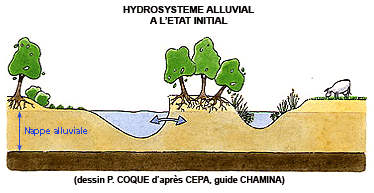|
In recent decades the Allier has been subjected to many developments to exploit its natural resources and give protection against its vagaries. Fortunately, it has not suffered an irreversible policy of raising its banks, like its sister the Loire, but these impairments have nevertheless profoundly affected its functioning and natural ecosystems. The sinking of the Allier's river bed is a symptom of profound dynamic imbalance with multiple consequences.
|
DYNAMIC IMBALANCE: SINKING OF THE RIVER BED
The vertical incision of the bed in its alluvial plain is to some degree a natural phenomenon. But gravel extraction, added to the effects of dams, and above all bank protection schemes, have resulted in a considerable deficit in solids in the river’s waters, thus severely aggravating the incision of the Allier, irrevocably tilting the dynamic balance (see "Fluvial Dynamics") towards erosion, with permanent imbalance.
The extraction of alluvia traps suspended solids in the river coming from upstream, thus causing a deficit downstream which causes gradual erosion of the river bed. Furthermore, by creating a break in the longitudinal slope of the river's profile, the extraction pits also generate regressive erosion of the river bed upstream of the depression. This deficit in solid flow could have been partially compensated for by lateral erosion of the banks, but such erosion has been limited by the many bank protection schemes that have been installed.
Sinking of the Allier’s bed in 50 years has been assessed at more than one metre on average, with a maximum of over three metres. Locally, the Allier has even reached bedrock, revealing outcrops of marl.
MULTIPLE CONSEQUENCES
One of the most serious consequences of bed sinking, both for the river and for mankind, is the associated lowering of alluvial groundwater levels, resulting in an enormous decrease in the quantity of our water resources. For this reason, many extraction wells have had to be deepened, while backwaters have been cut off from the river.
Incision has also made bridges vulnerable by uncovering their foundations. The collapse of the Wilson bridge at Tours in 1978 was due to sinking of the bed of the Loire. On the Allier, the Régemortes Bridge in Moulins, for example, has had to be strengthened.
The sinking and consequent narrowing of the bed have caused a reduction in hydro-dynamic constraints in associated systems, causing alluvial vegetation to be replaced by more commonplace vegetation, with forest colonizing previously bare beaches, etc.. This last development in itself entails a reduction in the channel cross-section of the normal bed which, in built-up zones, increases the risk of flooding.
FEWER AND DAMAGED NATURAL ECOSYSTEMS
In addition to the problems already mentioned, most of the natural ecosystems have already disappeared, or are in the process of disappearing, in favour of building, poplar plantations and intensive crops.
The alluvial forests are sometimes felled and replaced with plantations of hybrid poplars, devoid of ecological value and ineffective for slowing down flood waters or maintaining the banks. The riverside forests that used to be left by farmers immediately next to the watercourse to protect pastures from its whims (slowing overflow water, retaining flood-borne debris) have been removed, resulting in regular damage to much more vulnerable crops.
The transformation of alluvial forests and natural meadows into cultivated zones, apart from bringing with it chemical treatments, fertilizers and problems of winter erosion of bare soil, have destroyed the natural filters that preserved the alluvial groundwater.
The fluvial corridor formed by the river and its natural ecosystems is thus greatly reduced and often even fragmented.
Among the surviving natural habitats, many are deteriorating in quality due to water pollution. They are also often sullied with plastic bags and other refuse.
CONSEQUENCES OF ANTHROPOGENIC DAMAGE TO THE ALLIER VALLEY (Drawings by P. Coque, to data by CEPA, CHAMINA guide)

|














 Impairments
Impairments